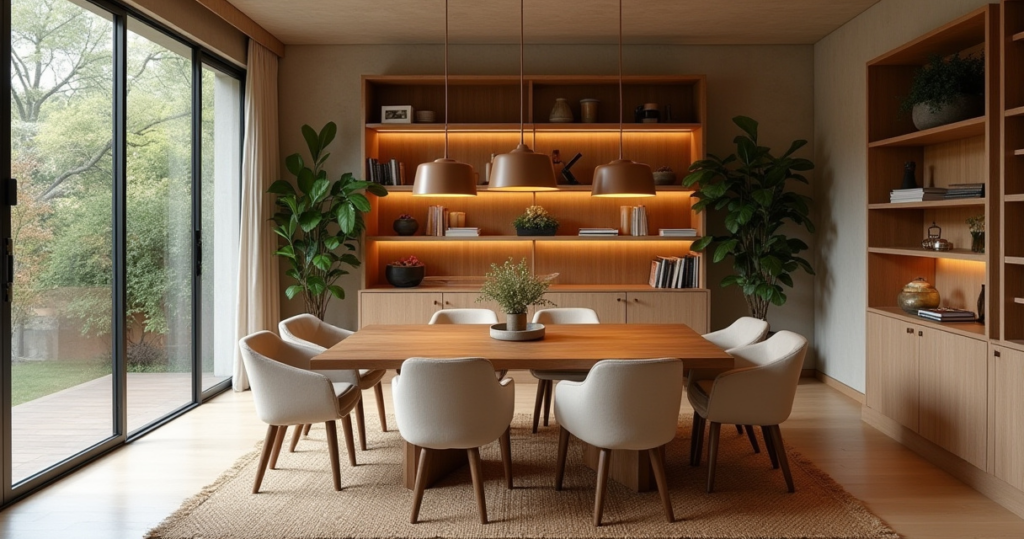Can we talk about why so many modern dining rooms feel… empty? I don’t mean empty of furniture. I mean empty of soul. You scroll through Pinterest and see these stark, minimalist spaces that look stunning in a photograph. A sleek table, identical chairs, one perfectly placed vase. It’s the very picture of European modernism. But when you imagine actually living there, sharing a meal, having a real conversation, it just falls flat. There’s no warmth, no story.
On the other hand, a purely traditional space can feel heavy and dated. The truth is, the most beautiful and livable dining rooms I’ve ever designed exist somewhere in the middle. They borrow the clean lines and functionality of the West and fuse them with the soul, texture, and philosophy of the East. It’s about creating a balance between sleek sophistication and natural harmony. It’s not just about what a room looks like; it’s about what it feels like. Forget the magazine spreads for a second. Let’s talk about creating a dining room that genuinely nourishes you.
Strategic Planning & Foundational Elements
Before you even think about a table, we need to talk about the invisible architecture of your dining room: its energy, its flow, its purpose. This is where European precision meets Vietnamese philosophy. Planning isn’t a chore; it’s the art of creating a space that feels intentional and effortless from the moment you step inside.
1. Define Your Ideal Dining Room Vibe for Cohesive Design
You know what people always ask me? “Where do I start?” They think it’s the paint color or the table. No. It starts with a feeling. In Vietnamese culture, we believe a space has a spirit, an energy. In European modernism, we talk about a ‘design concept’. I say they are the same thing. What do you want this room to feel like? A serene, zen-like retreat for quiet family meals? A vibrant, energetic hub for lively dinner parties? Write it down. Use words like ‘tranquil,’ ‘dramatic,’ ‘earthy,’ ‘formal.’
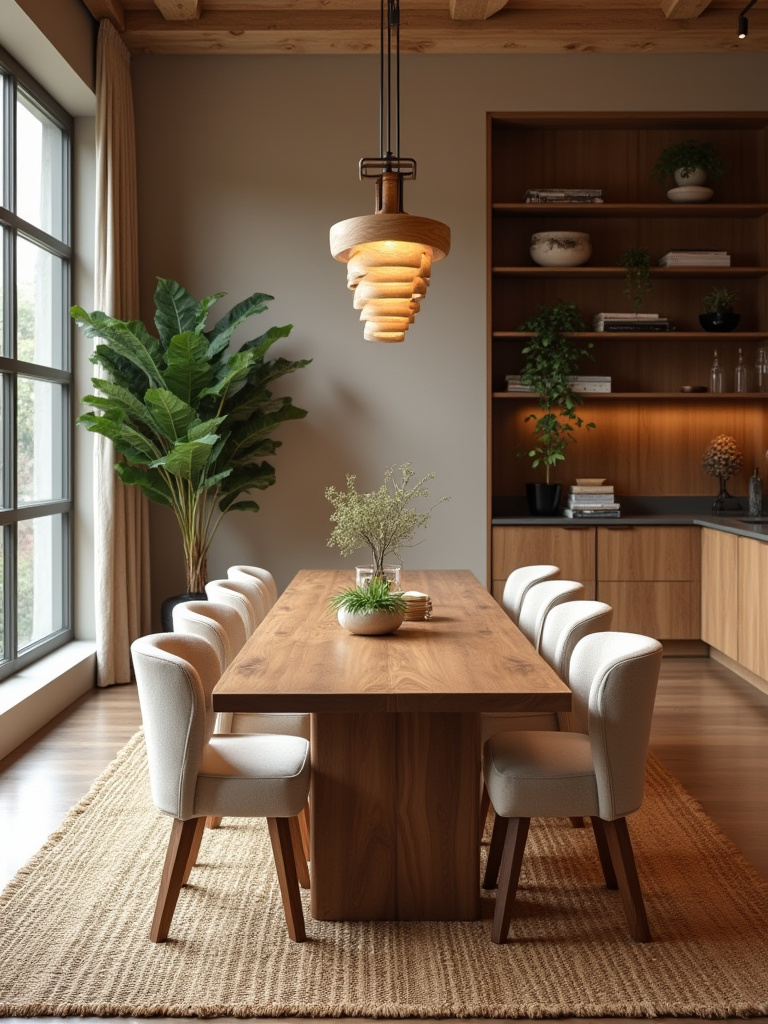
Without this north star, you’ll just buy a collection of nice things that don’t speak to each other. I once had a client who bought a gorgeous, austere marble table because it looked chic, but what their family actually needed was a warm, welcoming space for their young kids. The room felt cold and they never used it. We sold the table and started over, this time with the vibe: “cozy, durable, family hub.” This simple exercise saves you from costly mistakes and creates a room that aligns with your life, not just a trend.
This “vibe” isn’t just a word; it becomes the invisible thread that connects every choice, starting with how you and your guests move through the space.
2. Optimize Traffic Flow for Seamless Movement and Comfort
Western designers talk about “circulation paths.” In the East, we call it khí—the vital life force or energy that flows through a space. If your khí is blocked, the room feels stagnant and awkward. It’s that feeling you get when you have to squeeze past a chair, or the host can’t get around the table to serve. It creates subtle tension. Good flow is invisible. Bad flow is all you can feel.
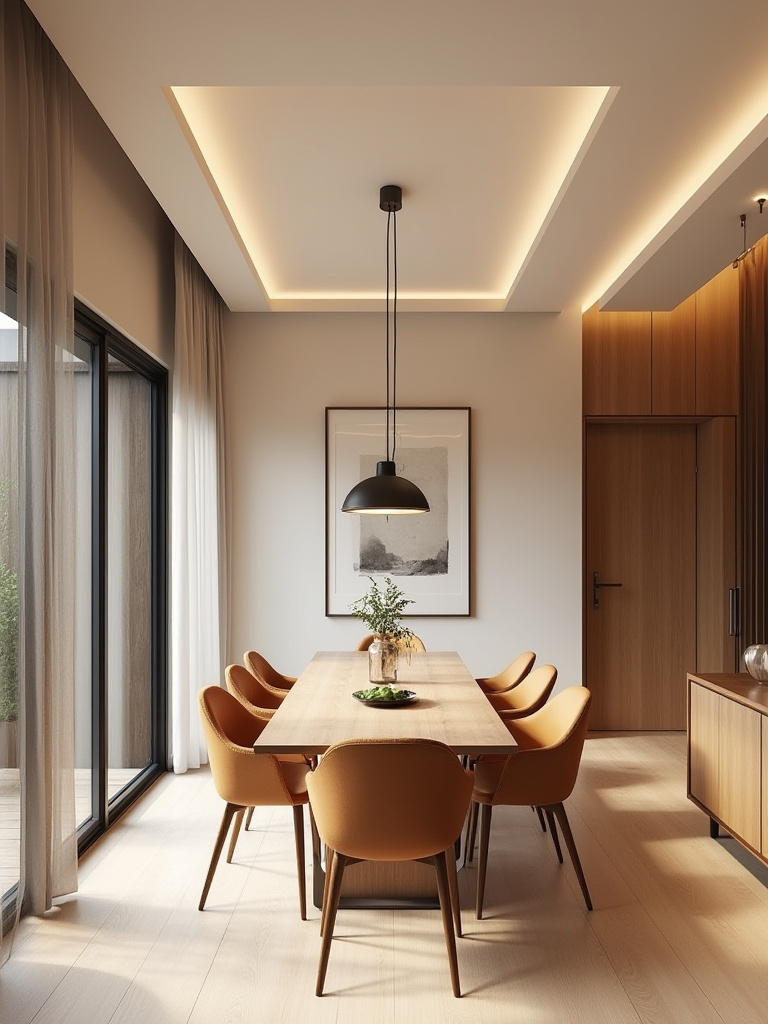
The common advice is to leave 36 inches around your table. I say 42 to 48 inches is where the real comfort lies, especially on main pathways. Tape it out on your floor. Walk the path from the kitchen to the table, from the door to a chair. Can you move with ease, even if someone is already seated? Don’t let a sideboard or a bar cart create a bottleneck. This isn’t just about avoiding bumps; it’s about allowing energy—and conversation—to circulate freely, making the entire experience feel more gracious and relaxed.
With energy flowing freely, you can begin to color the atmosphere, shaping the mood of the entire room.
3. Select a Harmonious Color Palette That Enhances Ambiance
Everyone says to pick colors you love. That’s true, but it’s not the whole story. Color is about balance—the interplay of Âm and Dương, shadow and light, calm and energy. A room that is all light, neutral tones (very modernist) can feel sterile. A room that is all dark, moody colors can feel oppressive. The magic is in the mix. Think about the five elements of Eastern philosophy (Ngũ Hành): Wood, Fire, Earth, Metal, Water. You don’t need to be a scholar to use this. It’s about balance. If you have sleek, cool metal chairs (Metal), warm them up with earthy terracotta or beige tones on the wall (Earth).
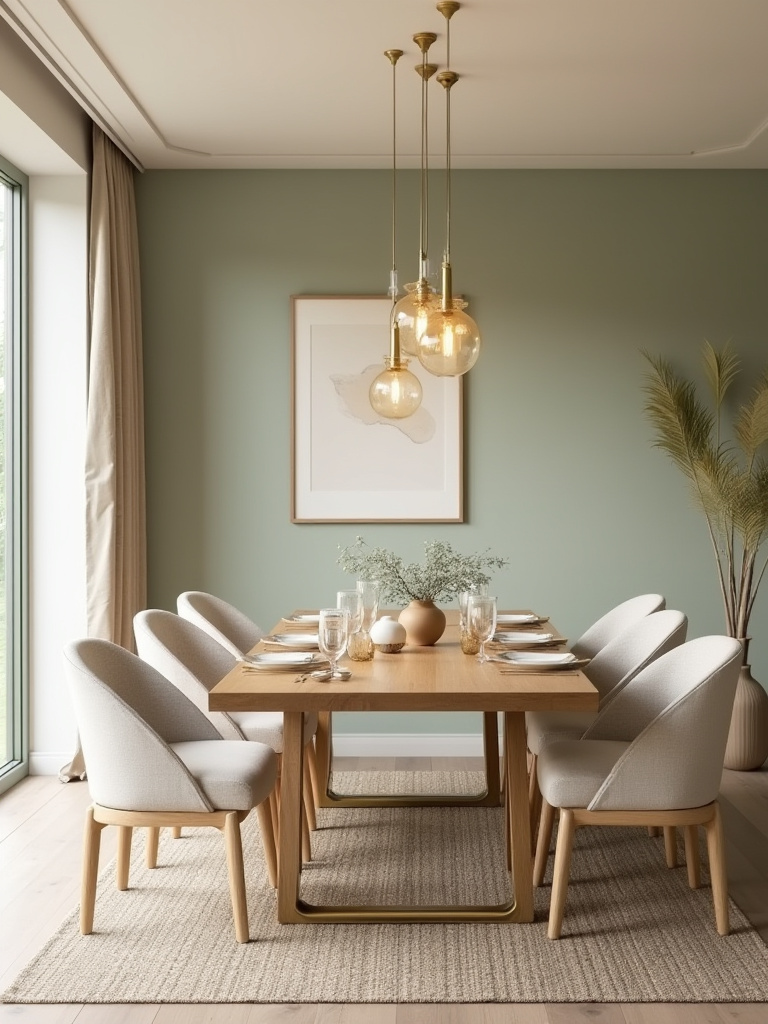
I learned this the hard way early in my career. I designed a stunning dining room in shades of gray and chrome for a client. It was the epitome of chic modernism. But they called me a month later saying it felt “sad.” We hadn’t given it any fire or earth. We brought in a single, oversized painting with deep reds and ochre, and added a warm, richly-grained wooden sideboard. The room came alive. Don’t just paint a room; compose it with color.
A balanced palette creates the perfect backdrop for the centerpiece of your dining room: the table.
4. Choose the Best Table Shape to Maximize Your Space
The shape of your table dictates the social dynamics of the room. A rectangular table creates a more formal feeling. It establishes a clear hierarchy, a head of the table. This is very European and perfect for formal entertaining. But a round table is pure community. Everyone faces each other, conversation flows more easily, and it feels more intimate. It’s the shape of a traditional Vietnamese family meal. There’s no head, just a circle of connection.
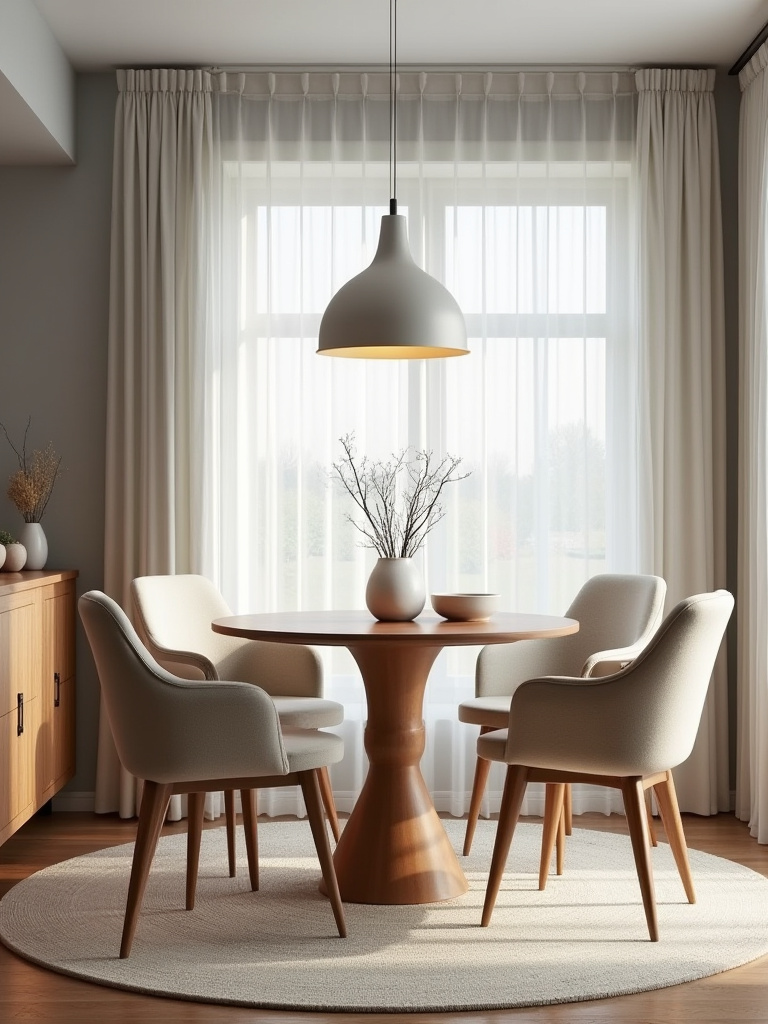
Don’t let the shape of your room trick you into thinking you need the same shape of table. A square room can be softened beautifully by a round table, which also dramatically improves the khí by eliminating sharp corners. I once had clients with a long, narrow dining space who were convinced they needed a long, skinny table. It felt like a boardroom. We switched it for a slender oval table, and the entire feeling of the room softened. It felt more gracious and made the room appear wider.
Once you’ve found the right shape, you can ensure it welcomes the right number of people with comfort and ease.
5. Plan for Ideal Seating Capacity and Guest Comfort
There’s a big difference between the number of people you can squeeze into a room and the number of people you can host comfortably. Vietnamese hospitality is generous. It’s about making your guests feel cherished and unhurried. The Western metric is 24 inches of space per person. I find this a bit tight. I aim for closer to 30 inches. It gives you elbow room, space to breathe, and makes the experience feel luxurious, not cramped.
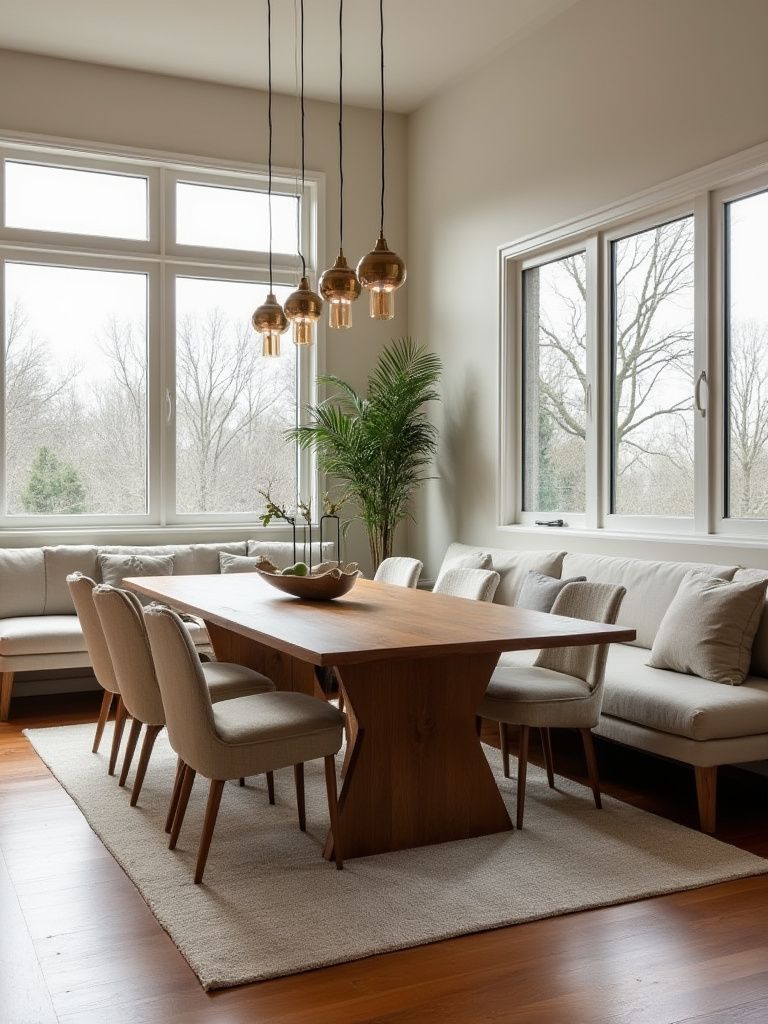
The shortcut everyone misses is planning for your most common use case, not the once-a-year holiday dinner. If it’s just your family of four 95% of the time, don’t live with a massive ten-person table that makes daily meals feel empty and distant. Get a beautiful table that fits your daily life perfectly and invest in a high-quality expandable option for when you host. It’s about respecting both the everyday ritual and the special occasion.
Now that the foundation is laid, we can start to layer in the pieces that give the room its true character.
Curating Furniture & Core Pieces
Furniture isn’t just functional; it’s sculptural. Each piece adds to the room’s story. Here, we’ll select the core elements—the table, chairs, and storage—that blend form and function, embodying that perfect fusion of clean lines and tactile warmth.
6. Select the Perfect Dining Table Size to Fit Your Needs
The biggest mistake people make is buying a table that’s too large for the room. It suffocates the space. Remember, empty space is a design material, too. It gives the eye a place to rest and the body room to move. It’s the pause in the music. Before you buy, take your room’s dimensions and subtract a generous 72 inches from the length and width. That result is the absolute maximum size your table should be. No exceptions.
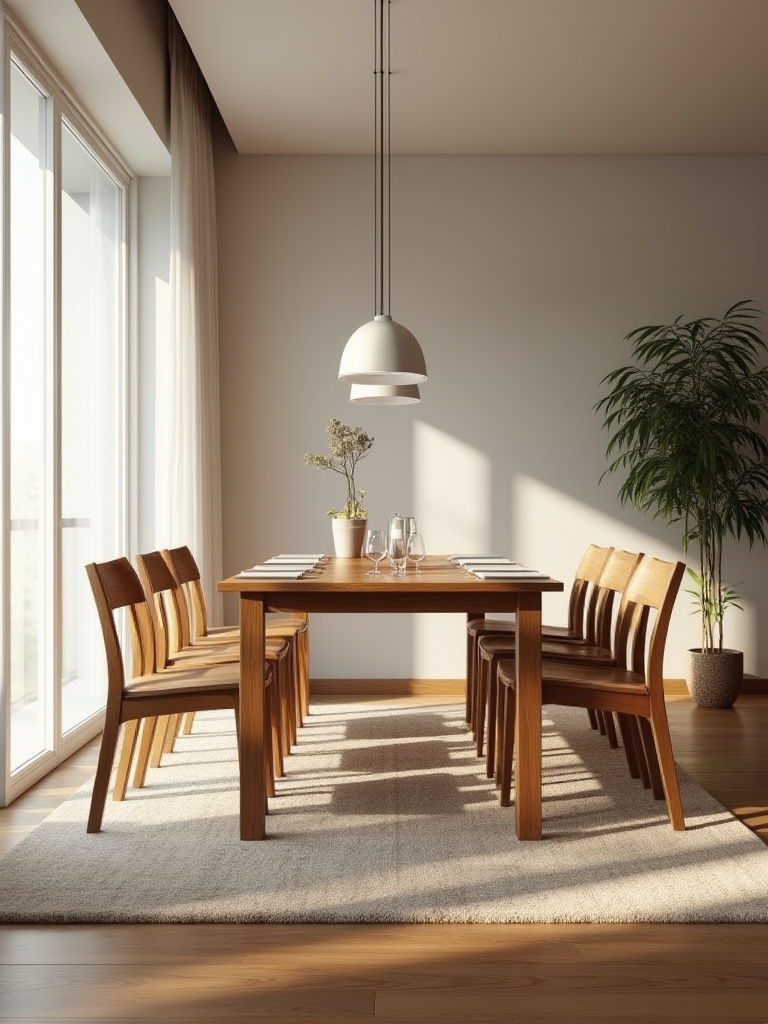
This simple rule ensures you have at least 36 inches on all sides, allowing the space to breathe. A client once fell in love with a massive, reclaimed wood table. It was beautiful, but it left barely two feet of clearance. Getting in and out of a chair was a strategic mission. It looked impressive but felt hostile. We found a visually lighter table with a sleeker profile and the room instantly felt twice as large and a hundred times more welcoming.
With the perfect table grounding the space, you can play with one of my favorite techniques: introducing character through seating.
7. Artfully Mix and Match Dining Chairs for Visual Interest
Forget the matching set. It’s a bit predictable, a bit too… catalogue. Mixing chairs is where you can truly express your unique style and tell a story. This is the perfect opportunity to practice our fusion philosophy. Imagine a sleek, minimalist European table. Now, instead of matching minimalist chairs, flank it with two beautiful, hand-carved wooden armchairs at the heads, and line the sides with chairs in woven rattan or textured upholstery. You’re pairing clean, modern lines with organic, natural craft.
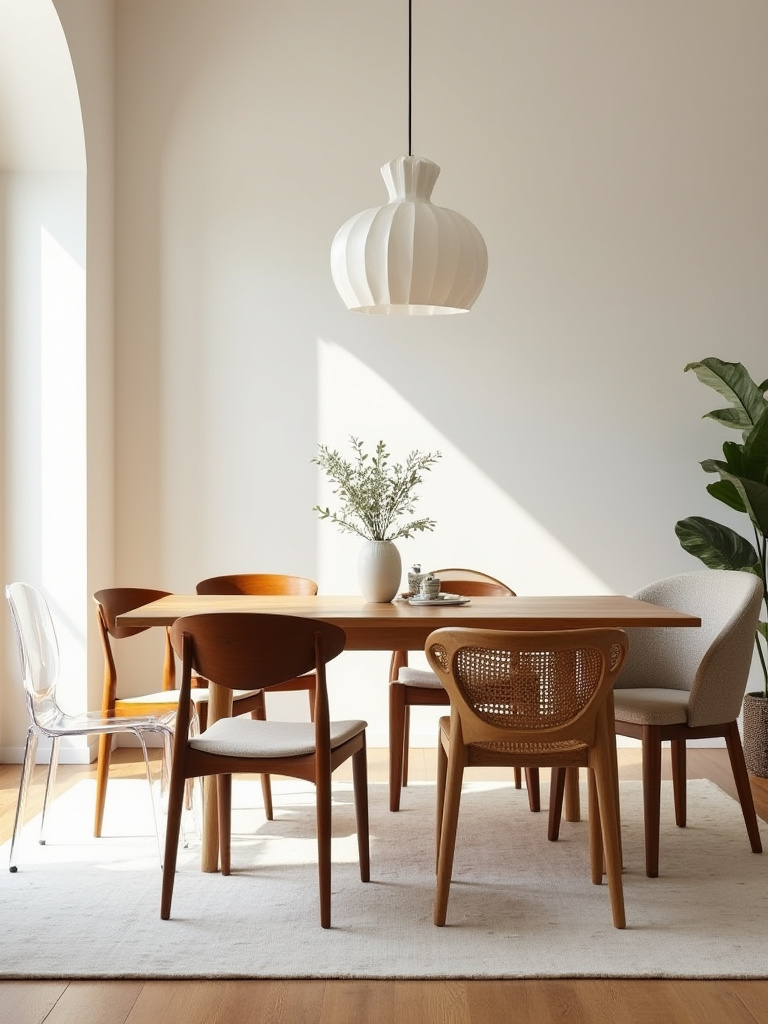
The key to getting it right is finding a common thread. It could be color (all chairs are black, but in different styles), material (all chairs are wood, but different shapes), or period (a collection of mid-century chairs). My confession? I used to think this looked messy. Then I realized it’s the design equivalent of a good conversation—different voices coming together to create something harmonious and interesting.
Once your seating tells a story, it’s time to add a piece that combines elegance with practical grace.
8. Integrate a Functional Sideboard or Buffet for Storage
A sideboard is so much more than a storage cabinet. In many Vietnamese homes, there’s a special place, an altar or cabinet, for displaying meaningful objects. I like to think of a sideboard as a modern, secular version of this. Yes, it should hide away your extra placemats and mismatched cutlery. But its surface is a stage. It’s the perfect place to create a beautiful vignette—a lamp for a soft glow, a piece of sculpture, a stack of art books, a vase of fresh flowers.
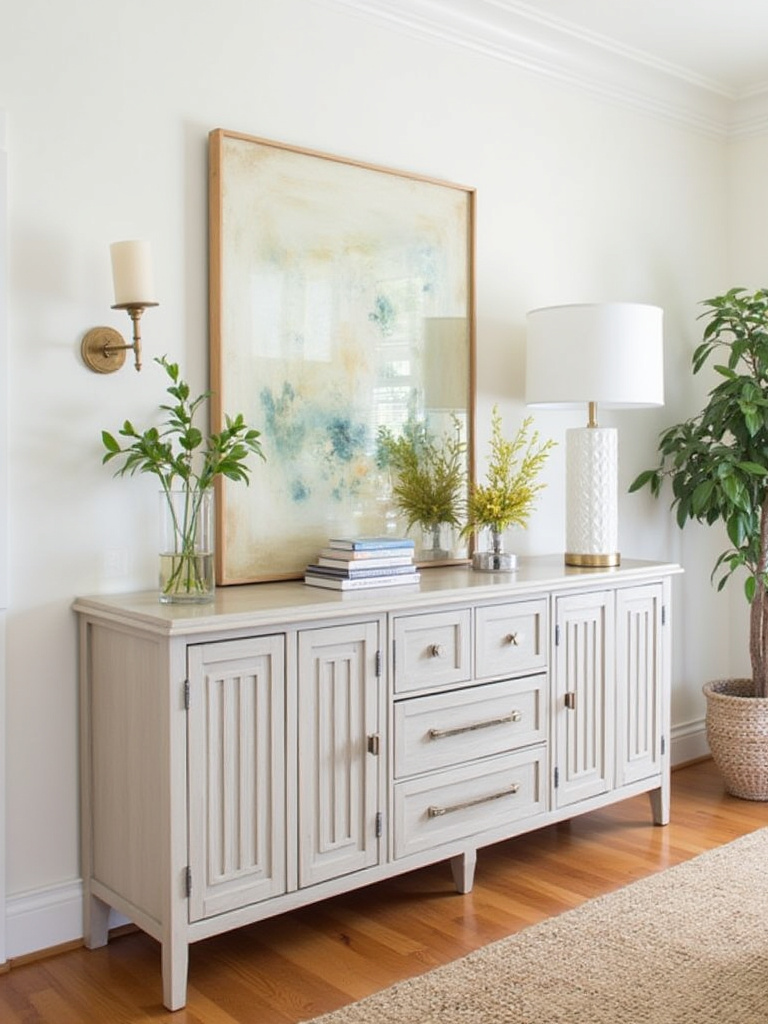
Instead of a bulky, matching piece from the same furniture line as your table, look for something with its own personality. Perhaps a vintage mid-century credenza to add warmth to a new build, or a sleek, lacquered piece to bring a touch of Vietnamese artistry into a rustic space. Choose one that’s proportionally correct for the wall—not too big, not too small—and ensure it doesn’t obstruct your precious traffic flow. It should serve the room, not dominate it.
From freestanding elegance, we can move to an even more integrated and space-savvy solution for seating.
9. Consider Space-Saving Built-In Seating like a Banquette
Banquettes are the secret weapon for creating intimacy and maximizing space. They have the efficiency of European design—pushing the table to the wall and opening up the room—but they create the feeling of a cozy, communal nook that is so central to Asian dining culture. A banquette instantly makes a space feel more like a chic little café or a welcoming family kitchen.
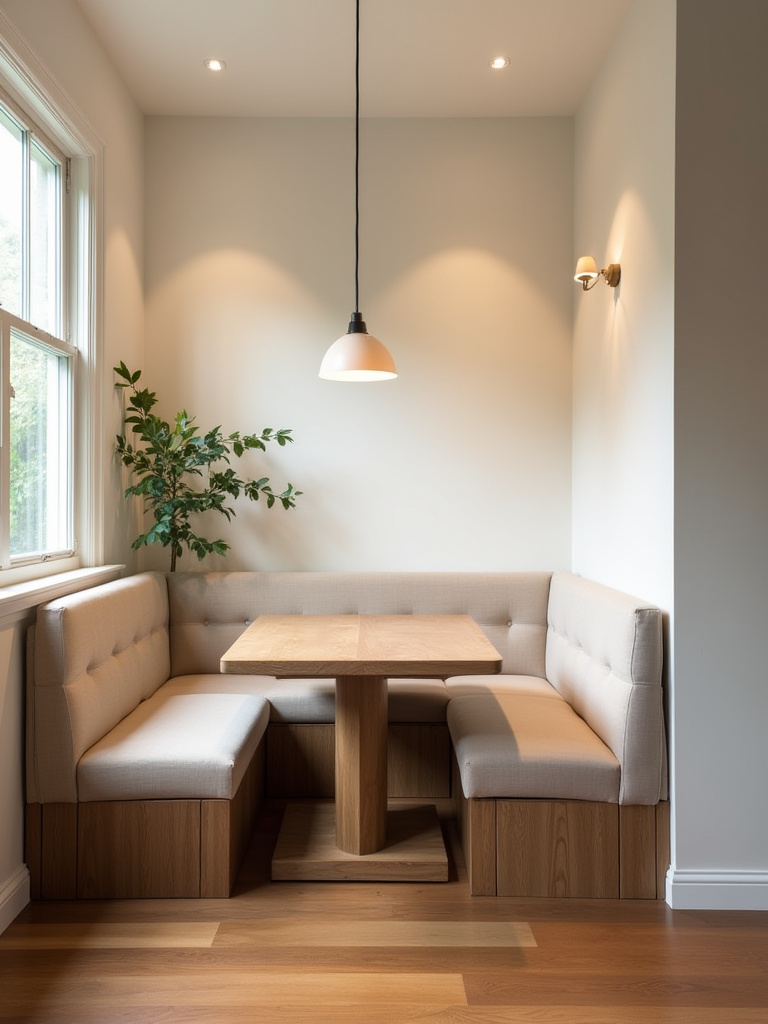
They are brilliant for small or awkward corners, turning otherwise dead space into the most coveted spot in the house. I designed a banquette for a family in a tight urban apartment, and it completely transformed how they used the space. It became the hub for everything: meals, homework, morning coffee, late-night chats. For ultimate functionality, always pair it with a pedestal table. This is non-negotiable. It allows people to slide in and out easily without navigating a forest of table legs.
Now that we’ve considered built-in elements, let’s add a touch of mobile elegance to the room.
10. Incorporate a Stylish, Versatile Bar Cart for Entertaining
A bar cart is pure European sophistication, a little jewel box on wheels. It’s a signal that this is a space for celebration and hospitality. But it shouldn’t look like a cluttered liquor store shelf. Curation is everything. Choose a few beautiful bottles, your favorite glassware, a stylish ice bucket, and some quality tools. It’s a functional display.
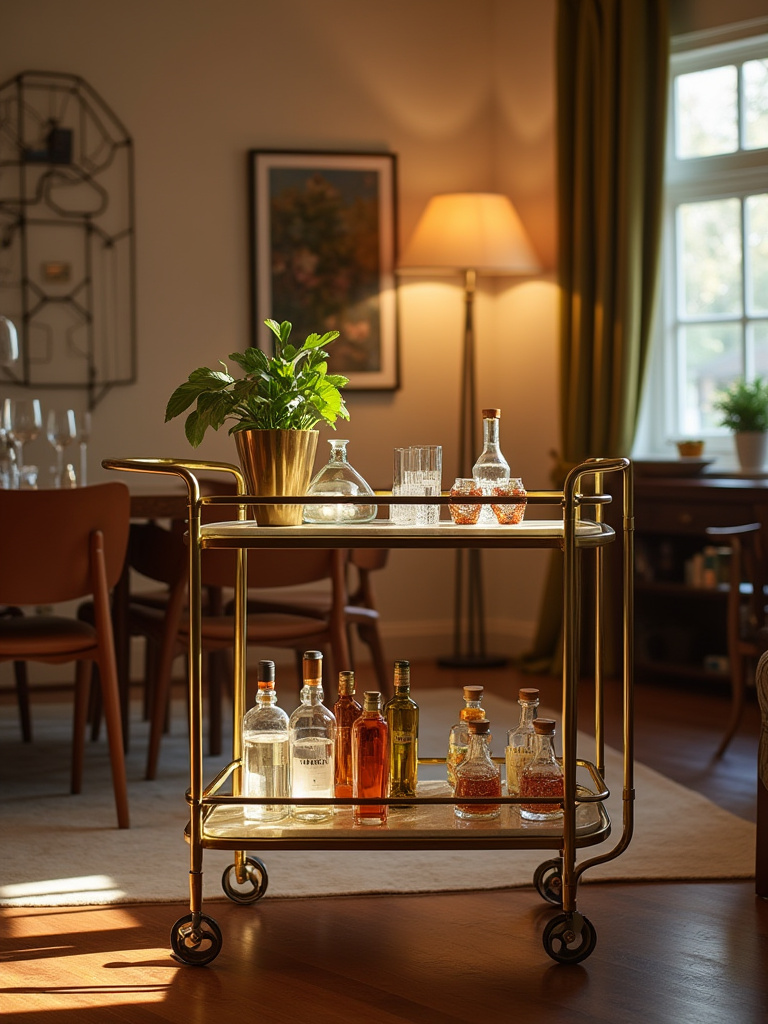
The trick is to make it feel like part of the room even when you’re not entertaining. I encourage my clients to think of it as a flexible surface. When not in use for cocktails, it can be a tea station, a dessert cart, or simply a beautiful stand for a plant and a few books. A sleek brass or chrome cart adds a metallic accent (the “Metal” element) that can beautifully balance a room rich in wood and textiles. It’s a small piece that delivers a major impact in both style and function.
With the furniture set, the next, and perhaps most crucial, step is to sculpt the atmosphere with light.
Crafting Ambiance Through Lighting
Lighting is everything. It is the single most powerful tool for changing the mood of a room. A common mistake is to install one, brutally bright light in the center of the ceiling and call it a day. This is a design tragedy. A well-lit dining room needs layers—just like a good soup—to create depth, warmth, and intrigue.
11. Install an Eye-Catching Statement Chandelier Above Your Table
Your chandelier is the punctuation mark for the entire room. It’s a piece of sculpture that also happens to give off light. This is your chance to make a statement, so don’t be timid. But a statement doesn’t have to mean giant and crystal-dripping. A statement can be a minimalist, sculptural form in brass. Or, it could be a piece that brings in natural texture—a chandelier made of hand-strung wooden beads or delicate silk lanterns, bringing a touch of Vietnamese craft to a modern space.
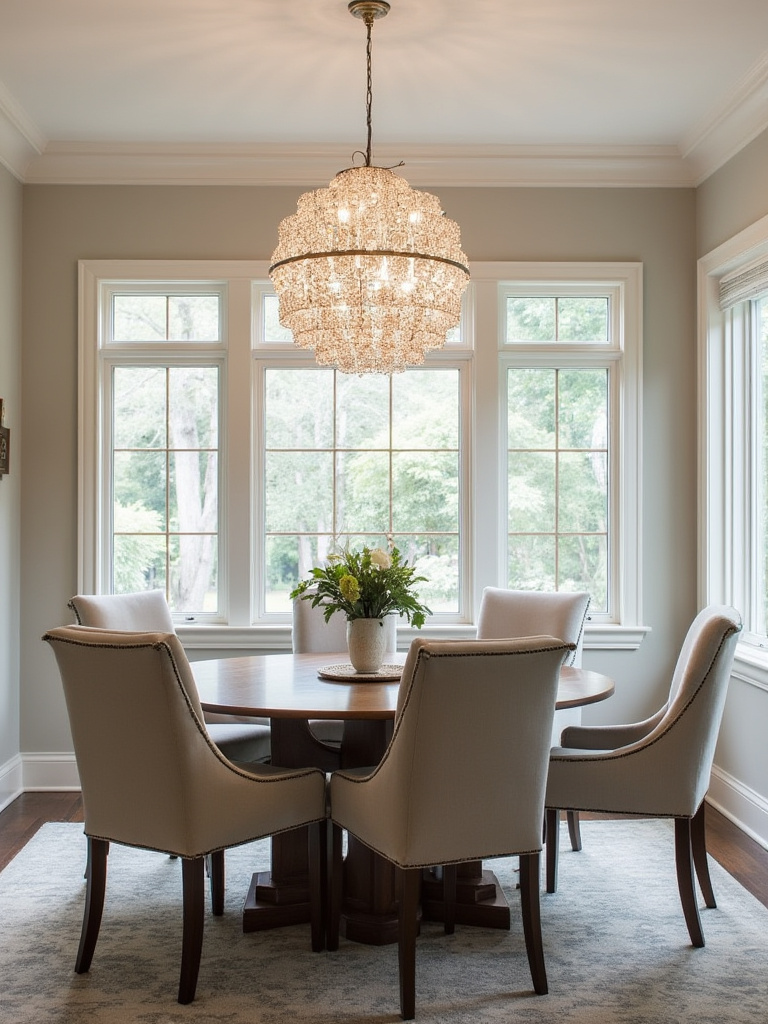
Here’s the shortcut you need: the chandelier’s diameter should be about half to two-thirds the width of your table. This keeps it in proportion. And it must—I repeat, must—hang 30 to 36 inches above your tabletop. Any higher and it gets lost in the ceiling; any lower and you’ll be knocking your head on it and blocking sightlines. Get this right, and it will anchor your entire room.
A stunning centerpiece is just the beginning; true mastery lies in creating a symphony of light.
12. Design a Multi-Layered Lighting Scheme for Versatility
Relying on just a chandelier is like trying to paint a masterpiece with a single color. You need layers. This is the ultimate expression of Âm (shadow) and Dương (light). You need a balanced lighting scheme that can adapt to any need.
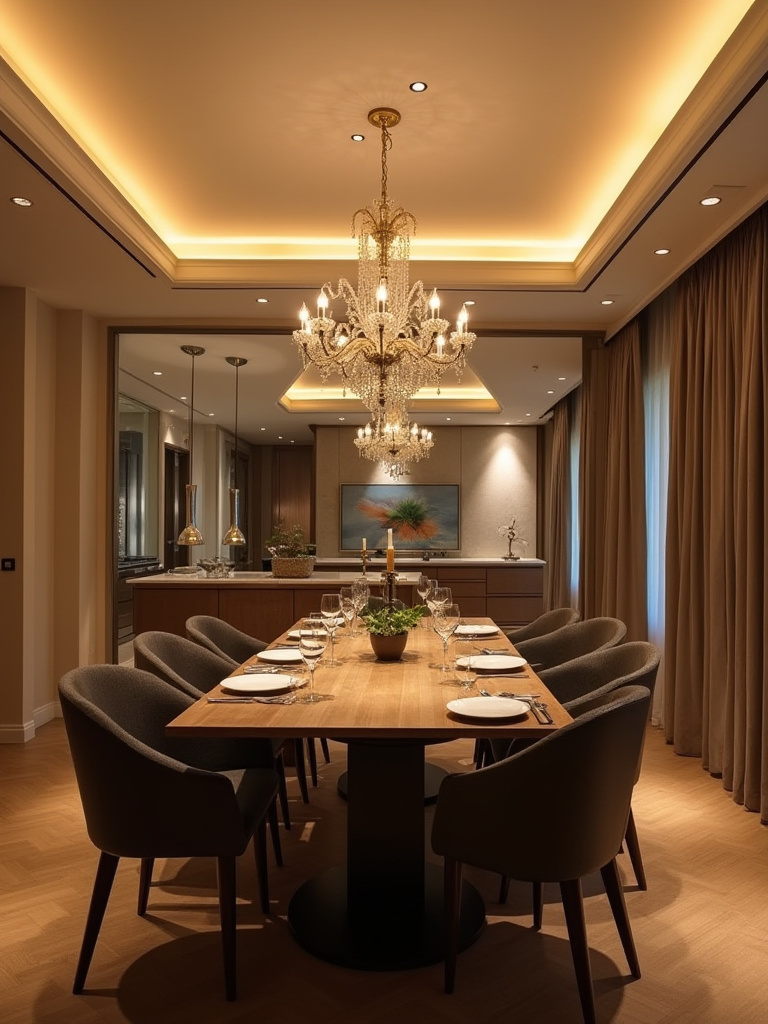
- Ambient Light: This is your general, overhead light, like the chandelier or recessed cans. It’s your base layer.
- Task Light: This is focused light where you need it, like a pendant over a buffet where you serve food.
- Accent Light: This is the magic layer. It’s a soft glow from a table lamp on a sideboard, a wall sconce washing a wall with light, or a picture light highlighting your art.
I designed a dining room for a couple who worked from home. During the day, they needed bright, clear light. In the evening, they wanted a romantic, restaurant-like atmosphere. By layering recessed lights, a central chandelier, and two wall sconces, all on separate dimmers, we gave them complete control. They could create any mood they wanted with the touch of a button. It made the one room feel like three.
The key to unlocking this versatility is one simple, non-negotiable tool.
13. Add Dimmer Switches for Adjustable Mood Control and Savings
If you do only one thing from this entire list, let it be this. Installing a dimmer switch is the single most effective, low-cost upgrade you can make to your dining room. A room without a dimmer is a room with one emotion: ON. A room with a dimmer is a room with a whole vocabulary of moods. It allows you to transition seamlessly from bright and functional for cleanup to a soft, intimate glow for dessert and conversation.
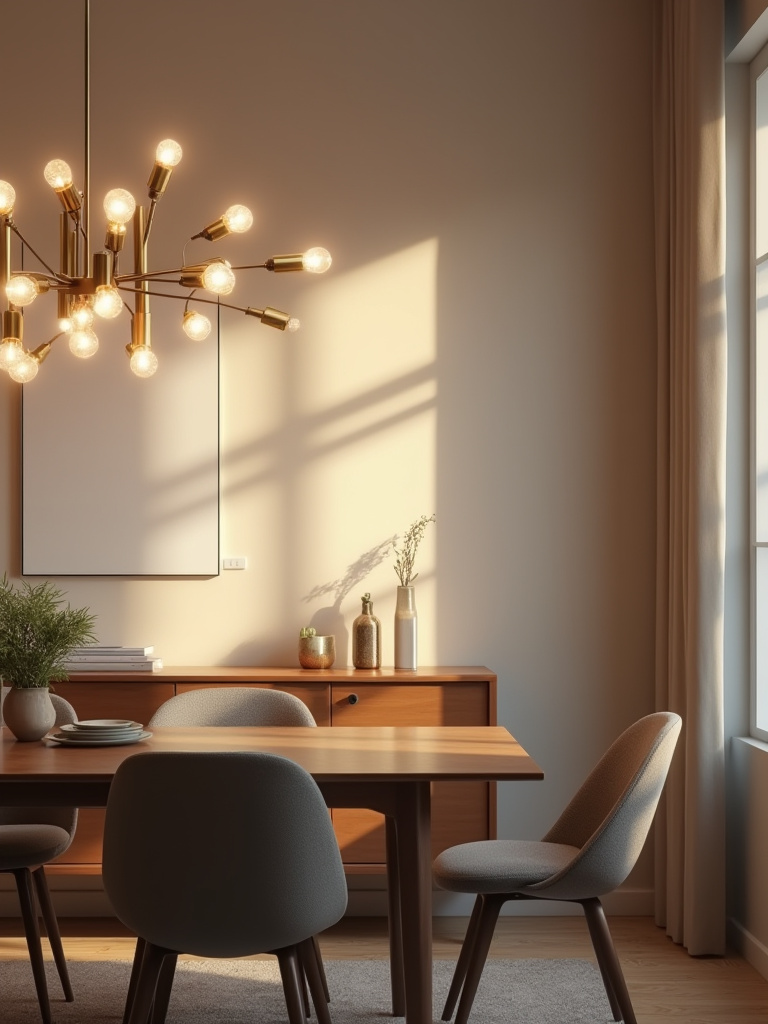
This isn’t just about mood; it’s about creating a more flattering environment. Bright, overhead light casts harsh shadows and is incredibly unflattering. A soft, dimmed light makes everyone and everything look better. I always tell my clients to put everything on a dimmer. The chandelier, the sconces, the recessed lights. This granular control is what separates an amateur room from a professionally designed space. It’s the secret to creating atmosphere.
While dimmers control the intensity, the placement of light sources shapes the feeling of the space.
14. Incorporate Ambient Wall Sconces or Pendants for Warmth
Light at eye level is what makes a space feel human. Overhead light illuminates a room, but light from sconces or low-hanging pendants creates intimacy. Think of the warm, gentle glow of lanterns in the ancient town of Hội An. They don’t flood the street with light; they create pools of warmth that feel magical and inviting. That’s what wall sconces do for your dining room.
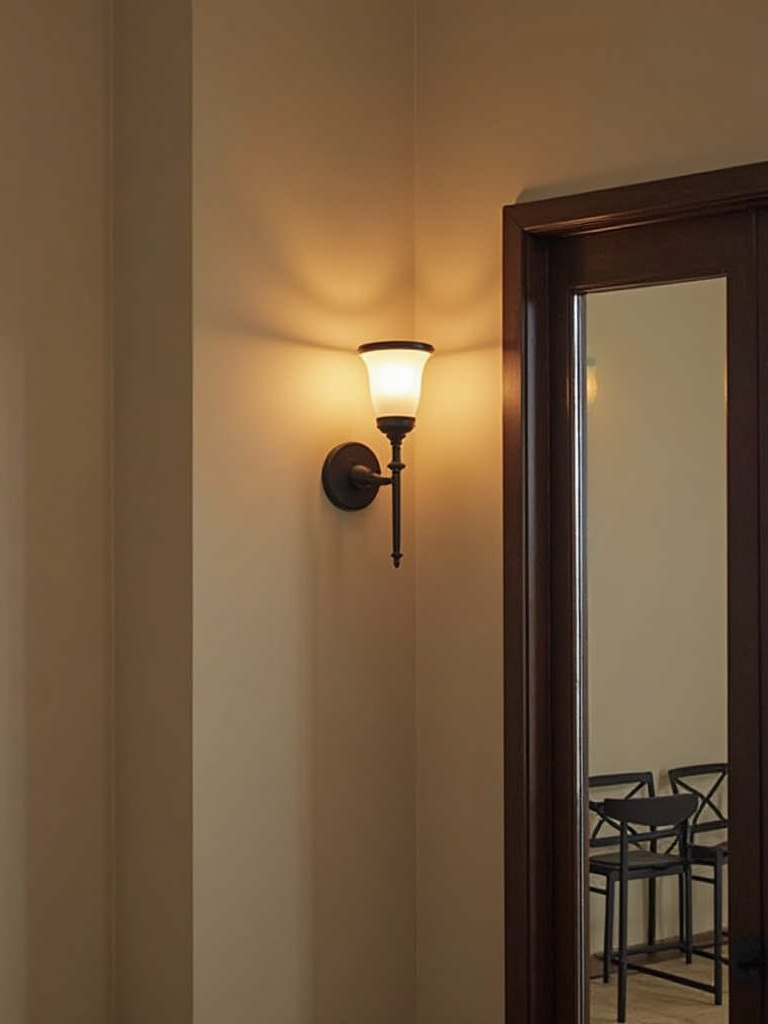
Placing a pair of sconces flanking a sideboard, a mirror, or a piece of art creates beautiful symmetry and a soft, welcoming glow. They wash the walls with light, which makes the room feel larger and less like a cave. The light they cast is indirect and diffuse, which is far more calming and comfortable for the eyes during a long meal than a direct glare from above. This is a layer that adds instant sophistication.
To complete our lighting symphony, we add one final touch of intimacy.
15. Utilize Table Lamps for Task and Accent Lighting
A lamp on a sideboard is one of my favorite design signatures. It’s an unexpected touch that brings a living-room level of coziness into the dining space. It immediately signals that this room is for more than just eating—it’s for lingering. The soft pool of light it creates is perfect for illuminating a serving area or simply adding a warm, ambient glow that softens the corners of the room.

Choose a lamp with some substance and style—it’s a decorative object as much as a light source. The shade is critical. A fabric shade in linen or silk will diffuse the light beautifully, casting a warm, inviting aura. This is that final, gentle layer of light that brings the illumination down to a human scale, making the space feel finished, thoughtful, and deeply comfortable.
With the room perfectly lit, it’s time to add the final layers of personality and story.
Accessorizing & Personalizing the Space
This is the fun part. The accessories are the soul, the personal signature. This is where your home stops looking like a showroom and starts telling your unique story. We’ll add art, texture, and life to transform the room from merely designed to truly cherished.
16. Create a Striking Gallery Wall or Artwork Feature
A bare wall is a wasted opportunity. Art is the fastest way to inject your personality into a space. A single, large-scale piece of art makes a bold, confident statement—very modernist. A gallery wall, on the other hand, tells a more intricate story. It can be a collection of family photos, travel sketches, or abstract prints. It feels collected and personal.
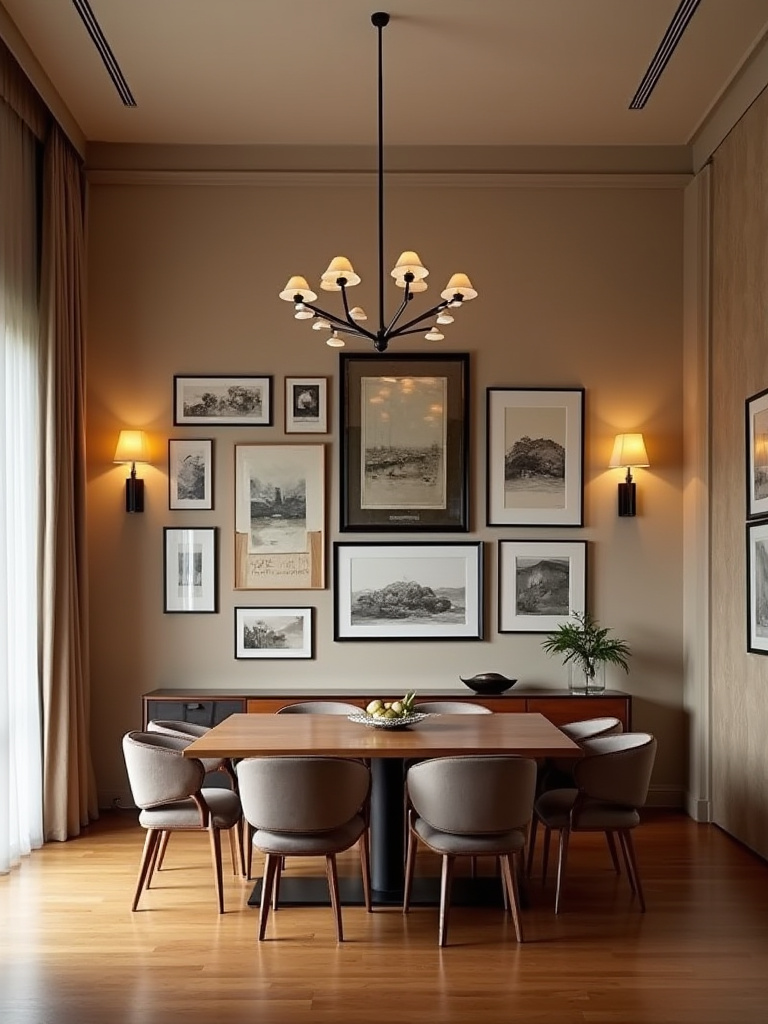
The secret to a successful gallery wall is to lay it all out on the floor first. Play with the arrangement until it feels balanced. I like to mix different frame styles and sizes but unify them with a common color palette—for instance, all black frames or all natural wood frames. And hang the center of the collection at eye level, around 57 inches from the floor. Don’t hang your art too high. It should feel connected to the furniture, not floating in space.
Art personalizes the walls, and a beautiful rug will ground the entire composition.
17. Select an Appropriately Sized Area Rug to Define the Zone
Everyone gets this wrong. They buy a rug that’s too small, and it ends up looking like a tiny, sad island in the middle of the room. The rule is simple and non-negotiable: the rug must be large enough so that when you pull a chair out to sit down, all four legs of the chair remain on the rug. This usually means the rug needs to extend at least 24 inches beyond the edge of your table on all sides.
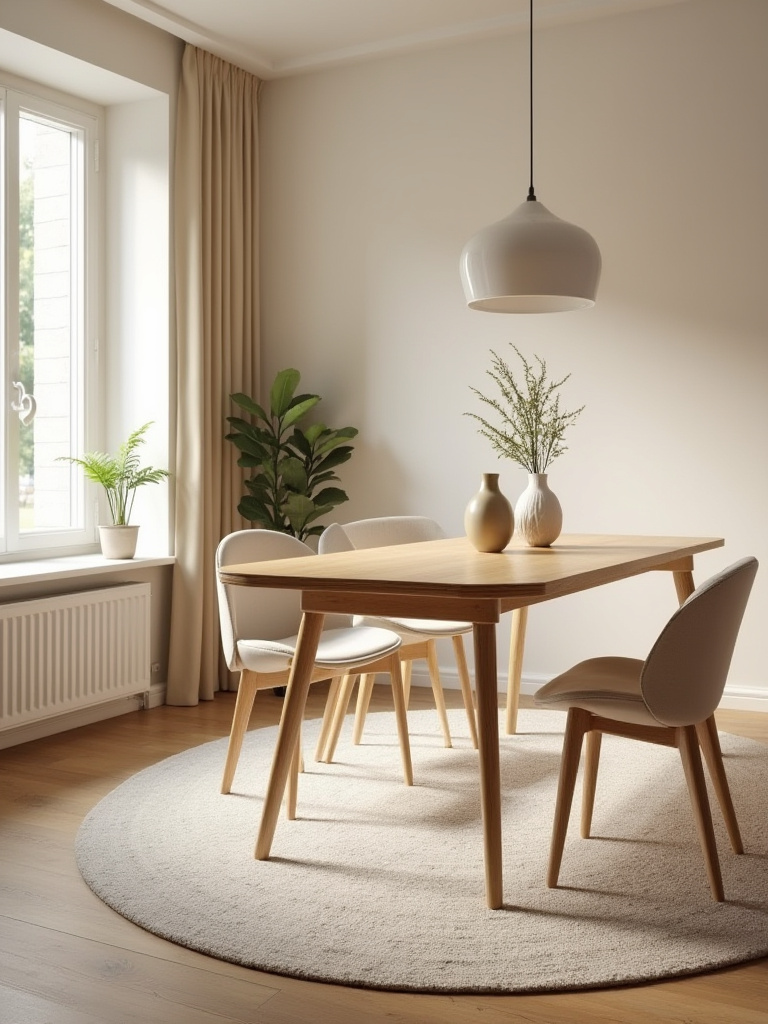
In an open-concept space, a rug is essential. It creates a “room within a room,” visually defining the dining zone and separating it from the living area. It also adds warmth, texture, and absorbs sound, making conversation clearer and the room quieter. I lean towards natural fibers like wool or jute. They have a beautiful, organic texture that grounds a modern space and adds a layer of comfort underfoot.
From the ground up, let’s now bring a touch of living nature into our design.
18. Integrate Greenery with Live or Faux Indoor Plants
A room without a living thing in it feels static. Plants are the easiest way to breathe life, quite literally, into your dining room. This is a core principle of biophilic design, which is central to both modern Scandinavian and traditional Asian aesthetics. It’s about our innate connection to nature. A touch of green can make a room feel healthier, calmer, and more vibrant.
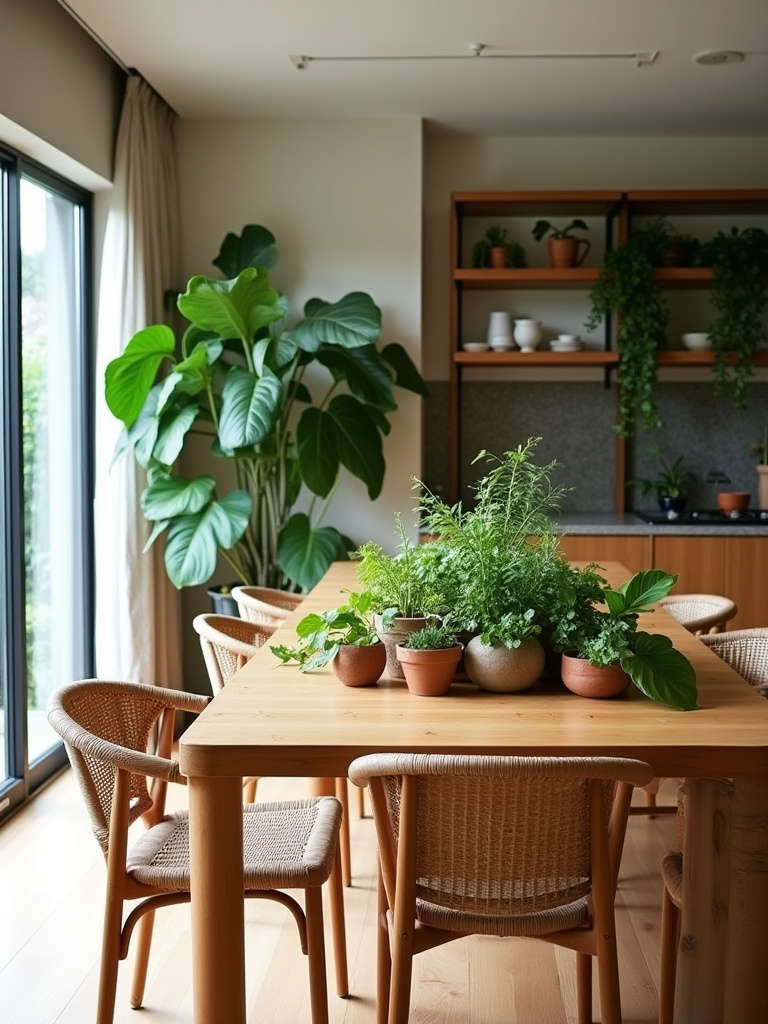
You don’t need a jungle. A single, elegant Fiddle-Leaf Fig in a corner can provide a beautiful, sculptural element. A few small succulents or a delicate orchid on the sideboard can add a touch of organic softness. If your room lacks natural light or you lack a green thumb, don’t be afraid of high-quality faux plants. The best ones today are incredibly realistic and offer the visual benefit without the maintenance. It’s the shape and color that matters.
Your personal story continues with the objects you choose to display.
19. Showcase Elegant Dinnerware or Collectibles in Displays
Don’t hide your beautiful things away. That beautiful set of ceramic bowls from your trip to Bat Trang village or your grandmother’s crystal glasses deserve to be seen. Displaying them in a glass-front cabinet or on open shelves turns everyday objects into art. It’s a celebration of craftsmanship and personal history. This is far more meaningful than displaying generic, store-bought decor.
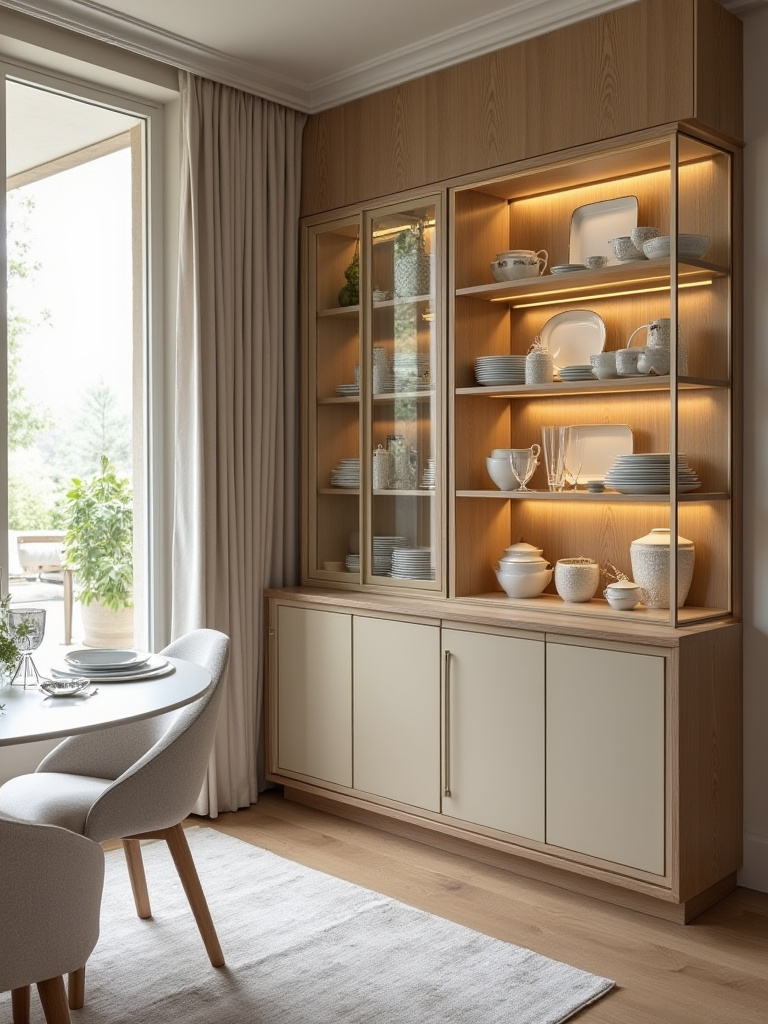
Curation is key. Don’t overcrowd the shelves. Give each piece or small grouping room to breathe. Think like a museum curator. I love to incorporate small, discreet LED puck lights or strips inside a cabinet. With the flick of a switch, it transforms a dark hutch into a luminous showcase, highlighting the sparkle of glass and the glaze of ceramics and adding a beautiful, ambient glow to the room.
To further enhance that glow, we turn to one of the oldest tricks in the design book.
20. Enhance Space with Thoughtfully Placed Decorative Mirrors
A mirror is a magical tool. In a small dining room, a large mirror can visually double the space, making it feel more open and airy. It’s a classic modernist trick for creating an illusion of depth. It can also act as a second window, especially if you place it opposite a real window to reflect the natural light and the view.
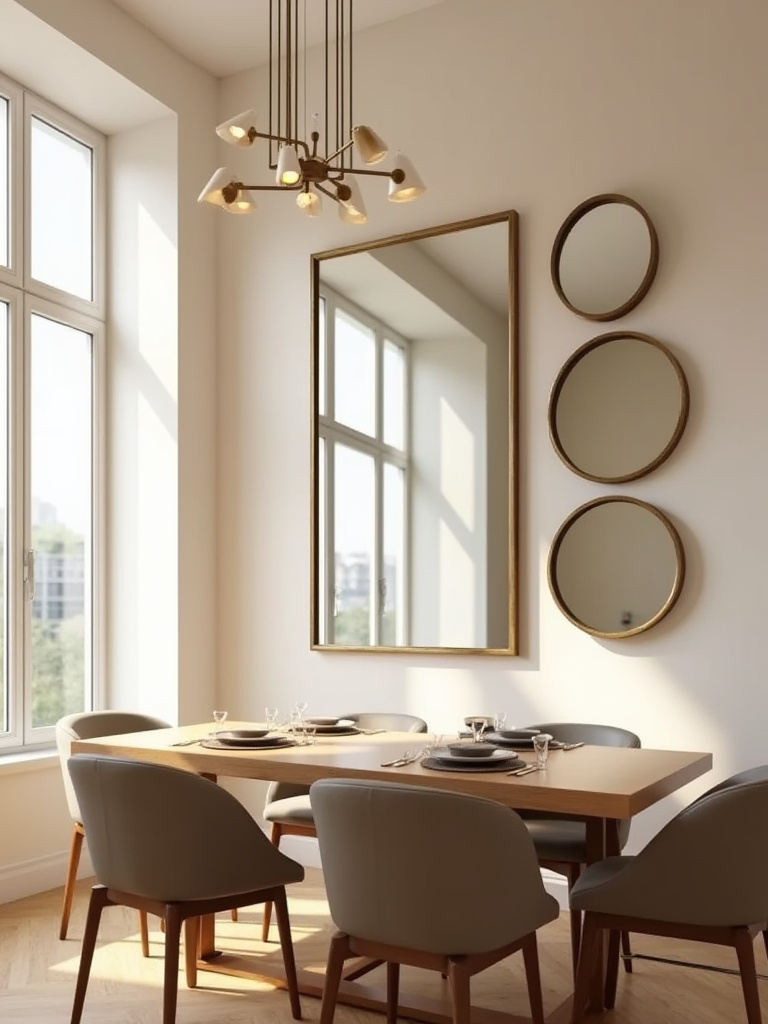
Be mindful of what it’s reflecting. A mirror that reflects a cluttered kitchen or a blank wall isn’t doing you any favors. I prefer to use them to reflect something beautiful, like your statement chandelier, a piece of art, or the flickering of candlelight during a dinner party. Consider a mirror with an interesting frame—an ornate gilt frame for a touch of antique glamour, or a simple, thin black metal frame for a more contemporary look. It’s functional art.
With the space now reflecting beauty, we can add a final layer of intelligent design.
Smart Solutions for Enhanced Functionality
A sophisticated space is also a smart space. Modern life demands flexibility. These final ideas are about embedding clever, functional solutions into your design, ensuring your dining room works as beautifully as it looks, adapting to any occasion with grace and ease.
21. Designate a Flexible Multi-Purpose Dining Zone for Adaptability
The formal, single-use dining room is a luxury many of us don’t have space for. Today’s dining room often has to be a home office, a homework station, or a craft area, too. The key is to design for this flexibility so it feels intentional, not chaotic. This is where clever, concealed storage is your best friend. A beautiful sideboard that secretly holds your laptop and files. A banquette with lift-top seats to store art supplies.
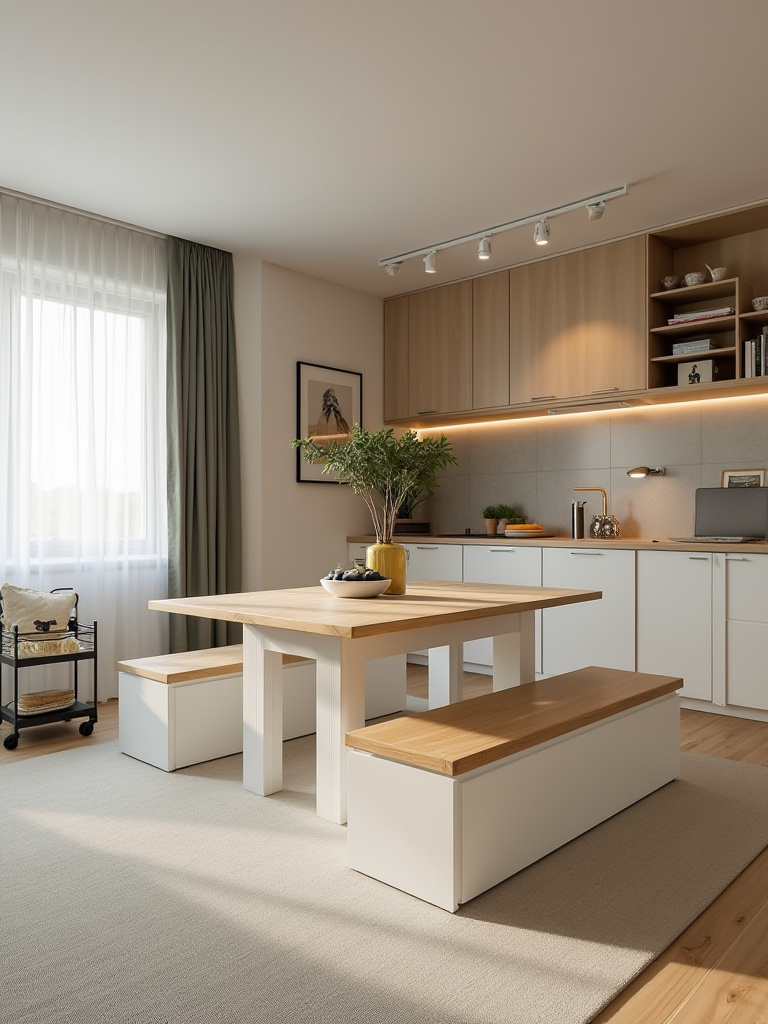
Use area rugs and lighting to create zones. The rug defines the dining space. During the day, the lighting can be bright and focused for work. In the evening, dim everything down, light a few candles, and it transforms back into an intimate space for dining. It’s about creating a room that works hard for you without ever looking like it’s breaking a sweat.
To support this hardworking space, we need a foundation that can withstand anything.
22. Choose Durable, Easy-to-Clean Flooring Options for Longevity
Your dining room floor puts up with a lot: scraping chairs, dropped forks, spilled wine. Choosing a floor that is both beautiful and bulletproof is one of the smartest investments you can make. The BS everyone tells you is that you need delicate hardwood. The truth is, modern materials can be more practical and just as beautiful. High-quality Luxury Vinyl Plank (LVP) offers the look of wood with incredible scratch and water resistance. Porcelain tile is nearly indestructible.
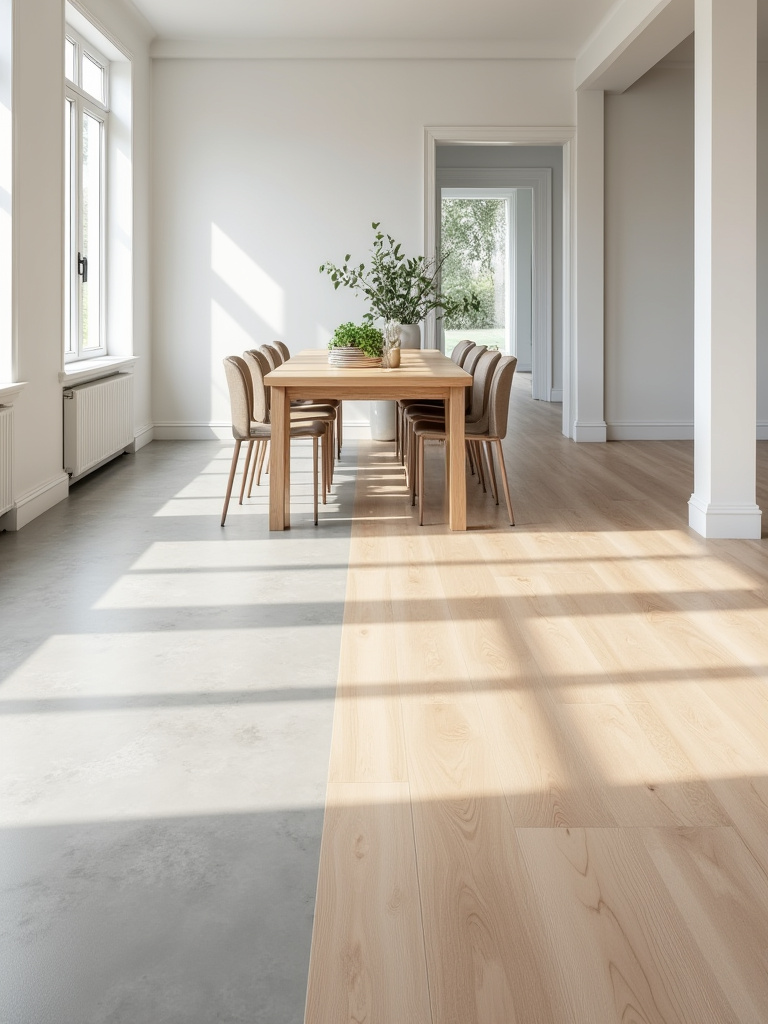
I worked with a family with young children and a large dog. They wanted the look of pale, Scandinavian oak but were terrified of ruining it. We used a commercial-grade LVP. It gave them the exact aesthetic they wanted with zero stress. They could spill, drop, and splash without a second thought. True luxury isn’t about delicate materials; it’s about a lack of worry.
From the floor up, we now apply the same smart thinking to our storage.
23. Maximize Storage with Vertical Shelving or Cabinets
In small spaces, you have to go up. Using vertical space for storage is a core modernist principle for efficiency. Floor-to-ceiling cabinets or a tall, slender hutch can provide an enormous amount of storage without taking up a large footprint. This keeps the floor plane clear, which helps the room feel larger and improves the flow of khí.
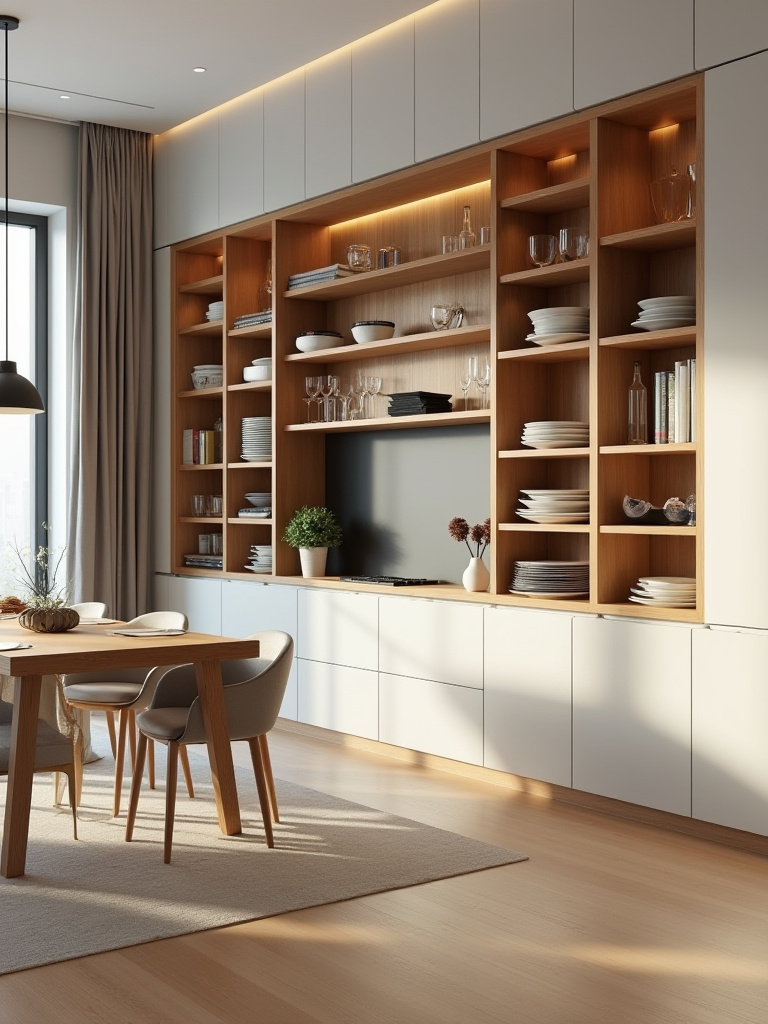
This can also be a design feature. A wall of built-in shelves allows you to create a beautiful, library-like display of books, ceramics, and glassware. It adds architectural interest and a huge amount of personality. Just be sure to balance your displayed items with some closed storage to hide away the less sightly necessities. It’s the balance of show and conceal that creates a look that’s both stylish and serene.
Finally, we arrive at the single most versatile piece of furniture you can own.
24. Select an Expandable Table to Host More Guests Effortlessly
This is the ultimate smart solution, the perfect fusion of daily function and celebratory tradition. An expandable table honors your everyday life by not overwhelming the room, but it also respects the importance of gathering with a larger community. It gives you the best of both worlds. You can have your cozy, intimate family dinner on a Tuesday, and then effortlessly accommodate twelve for a holiday feast on a Saturday.
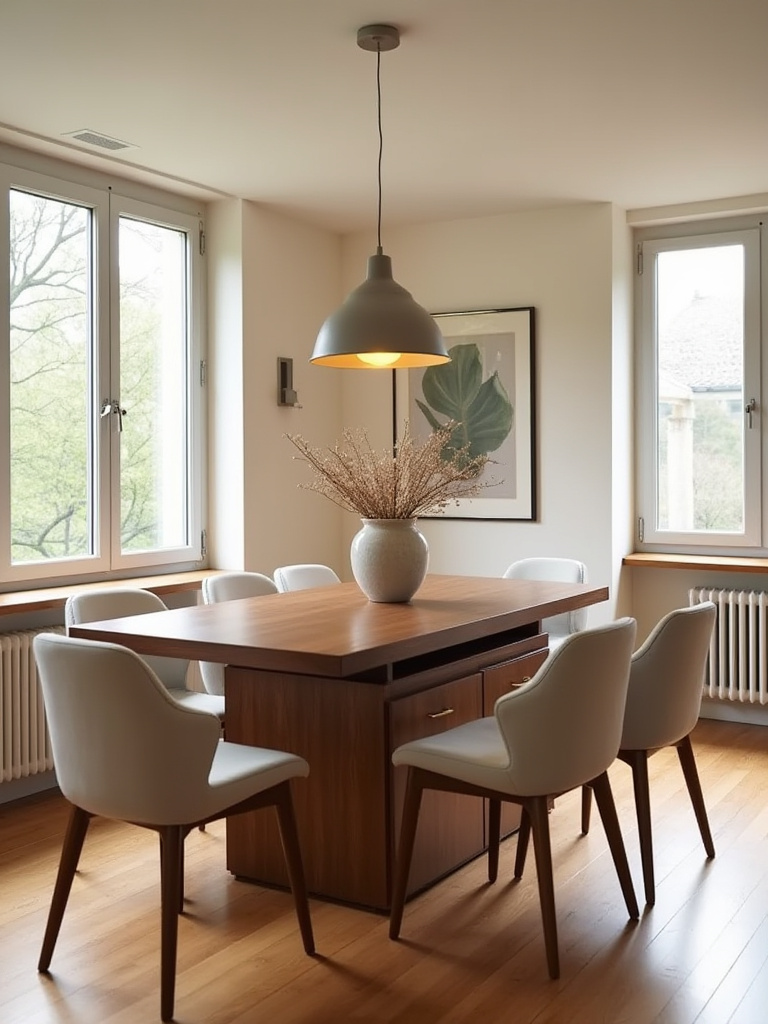
Invest in a quality mechanism. Cheaper tables have flimsy extension systems that can sag or stick. A well-engineered table with self-storing leaves is a piece of brilliance. There’s no need to find a place to store the extra leaves, and setting up for a party takes seconds. It’s the epitome of functional, adaptable design, and it’s the piece that will allow your dining room to evolve with your life.
The Art of Gathering
Creating a dining room isn’t a checklist exercise. It’s an act of deep consideration for how you want to live and how you want to make others feel in your home. It’s about finding the balance between clean, modern function and the warm, soulful spirit that makes a space come alive. By blending the precision of the West with the heart of the East, you can create a room that is more than just beautiful—it’s resonant.
Don’t be afraid to mix, to layer, to choose pieces that have meaning to you. Your dining room should be a reflection of your story, a backdrop for future memories. Start small. Pick one idea—a dimmer switch, a plant, a new piece of art. The journey to a perfect dining room is made of small, intentional steps. Create a space that invites you to linger, that sparks conversation, and that truly feels like the heart of your home.
